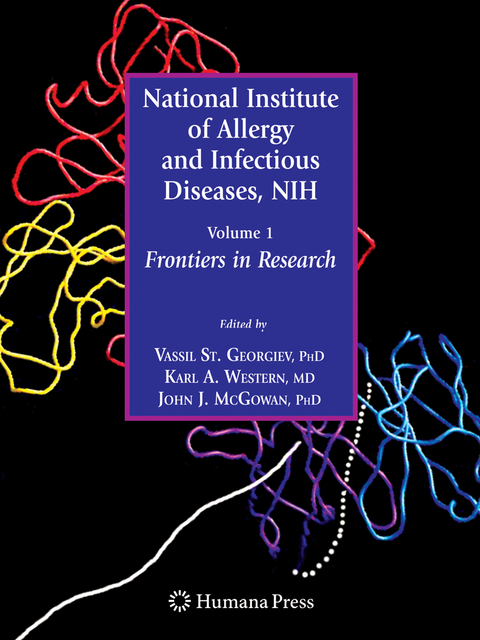
National Institute of Allergy and Infectious Diseases, NIH
Humana Press Inc. (Verlag)
978-1-61737-944-4 (ISBN)
Extensive and in-depth, National Institute of Allergy and Infectious Diseases, NIH: Volume 1, Frontiers in Research is a valuable, comprehensive guide to the state of research today.
National Institute of Allergy and Infectious Diseases (NIAID): An Overview.- Microbiology and Infectious Diseases.- Biotools for Determining the Genetics of Susceptibility to Infectious Diseases and Expediting Research Translation Into Effective Countermeasures.- Spore Surface Components and Protective Immunity to Bacillus anthracis.- New Candidate Anthrax Pathogenic Factors.- Ehrlichiae and Ehrlichioses: Pathogenesis and Vector Biology.- Multiple Locus Variable Number Tandem Repeat (VNTR) Analysis (MLVA) of Brucella spp. Identifies Species-Specific Markers and Insights into Phylogenetic Relationships.- Expression of the MtrC-MtrD-MtrE Efflux Pump in Neisseria gonorrhoeae and Bacterial Survival in the Presence of Antimicrobials.- What can Mycobacteriophages Tell Us About Mycobacterium tuberculosis?.- Clinical Mycobacterium tuberculosis Strains Differ in their Intracellular Growth in Human Macrophages.- Mechanisms of Latent Tuberculosis: Dormancy and Resuscitation of Mycobacterium tuberculosis.- Separating Latent and Acute Disease in the Diagnosis of Tuberculosis.- Mutant Selection Window Hypothesis: A Framework for Anti-mutant Dosing of Antimicrobial Agents.- The NIAID Influenza Genome Sequencing Project.- Lessons From the 1918 Spanish Flu Epidemic in Iceland.- Control of Notifiable Avian Influenza Infections in Poultry.- Understanding the Complex Pathobiology of High Pathogenicity Avian Influenza Viruses in Birds.- Development of Prophylactics and Therapeutics Against the Smallpox and Monkeypox Biothreat Agents.- The Hierarchic Informational Technology for QSAR Investigations: Molecular Design of Antiviral Compounds.- Antivirals for Influenza: Novel Agents and Approaches.- Anti-Infectious Actions of Proteolysis Inhibitor ?-Aminocaproic Acid (?-ACA).- A New HighlyPotent Antienteroviral Compound.- Reduction and Possible Mechanisms of Evolution of the Bacterial Genomes.- Interaction of Yersinia pestis Virulence Factors with IL-1R/TLR Recognition System.- IS481-Induced Variability of Bordetella pertussis.- Microarray Immunophosphorescence Technology for the Detection of Infectious Pathogens.- Development of Immunodiagnostic Kits and Vaccines for Bacterial Infections.- Research in Emerging and Re-emerging Diseases in Central Asia and the Caucasus: Contributions by the National Institute of Allergy and Infectious Diseases and the National Institutes of Health.- Disease Surveillance in Georgia: Benefits of International Cooperation.- Epidemiology (Including Molecular Epidemiology) of HIV, Hepatitis B and C in Georgia: Experience From U.S.—Georgian Collaboration.- The National Tuberculosis Program in the Country of Georgia: An Overview.- Human Immunodeficiency Virus and Aids.- Virus Receptor Wars: Entry Molecules Used for and Against Viruses Associated with AIDS.- HIV Latency and Reactivation: The Early Years.- HIV-1 Sequence Diversity as a Window Into HIV-1 Biology.- Human Monoclonal Antibodies Against HIV and Emerging Viruses.- Biological Basis and Clinical Significance of HIV Resistance to Antiviral Drugs.- NIAID HIV/AIDS Prevention Research.- Epidemiological Surveillance of HIV and AIDS in Lithuania.- Immunology and Vaccines.- TACI, Isotype Switching, CVID, and IgAD.- A Tapestry of Immunotherapeutic Fusion Proteins: From Signal Conversion to Auto-stimulation.- A Role for Complement System in Mobilization and Homing of Hematopoietic Stem/Progenitor Cells.- Post-translational Processing of Human Interferon- ? Produced in Escherichia coli and Approaches for its Prevention.- B-cell Dysfunctions in Autoimmune Diseases.- A ModelSystem for Studying Mechanisms of B-cell Transformation in Systemic Autoimmunity.- Breach and Restoration of B-cell Tolerance in Human Systemic Lupus Erythematosus (SLE).- Dendritic Cells: Biological and Pathological Aspects.- Immunomic and Bioinformatics Analysis of Host Immunity in the Vaccinia Virus and Influenza A Systems.- Immunoreactions to Hantaviruses.- Innate Immunity to Mouse Cytomegalovirus.- Research and Development of Chimeric Flavivirus Vaccines.- Correlates of Immunity Elicited by Live Yersinia pestis Vaccine.- Building a Sustainable Personal Research Portfolio.- Strategies for a Competitive Research Career.- Selecting the Appropriate Funding Mechanism.- Preparing and Submitting a Competitive Grant Application.- Identifying Research Resources and Funding Opportunities.
| Erscheint lt. Verlag | 19.11.2010 |
|---|---|
| Reihe/Serie | Infectious Disease |
| Zusatzinfo | 92 Illustrations, color; 115 Illustrations, black and white; XVIII, 530 p. 207 illus., 92 illus. in color. |
| Verlagsort | Totowa, NJ |
| Sprache | englisch |
| Maße | 210 x 279 mm |
| Themenwelt | Medizin / Pharmazie ► Medizinische Fachgebiete ► Dermatologie |
| Studium ► Querschnittsbereiche ► Infektiologie / Immunologie | |
| Naturwissenschaften ► Biologie ► Mikrobiologie / Immunologie | |
| ISBN-10 | 1-61737-944-1 / 1617379441 |
| ISBN-13 | 978-1-61737-944-4 / 9781617379444 |
| Zustand | Neuware |
| Haben Sie eine Frage zum Produkt? |
aus dem Bereich


